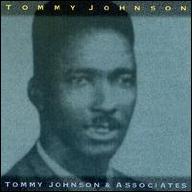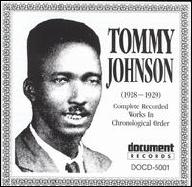The legend of Tommy Johnson is even harder to ignore. The stories about his live performances -- where he would play the guitar behind his neck in emulation of Charley Patton's showboating while hollering the blues at a full-throated level for hours without a break -- are part of it. So is his uncontrolled womanizing and alcoholism, both of which constantly got him in trouble. Johnson's addiction to spirits was so pronounced that he was often seen drinking Sterno -- denatured alcohol used for artificial heat -- or shoe polish strained through bread for the kick each could offer when whiskey wasn't affordable or available in dry counties throughout the South. Then there's the crossroads story. Yes, years before the deal with the Devil at a deserted Delta crossroad was being used as an explanation of the otherworldly abilities of young Robert Johnson, the story was being told repeatedly about Johnson, often by the man himself to reinforce his abilities to doubting audiences.
Then there's the music. His Cool Water Blues got amped up in the '50s by one of his early admirers, Howlin' Wolf, and became I Asked for Water (She Brought Me Gasoline). Another signature piece, his Maggie Campbell came with a chord progression that was used for infinite variations by blues players dating all the way back to his contemporary Charley Patton and up through Robert Nighthawk. Two of his best-known numbers have survived into modern times; Big Road Blues is probably best known to contemporary blues fans from adaptations by Floyd Jones and others, while his Canned Heat Blues -- a bone-chilling account of his complete addiction to alcohol and his slavish attempts to score it by whatever means necessary -- was the tune that gave a California blues-rock band its name. After a while, all of the above starts adding up: no matter how you slice it, Tommy Johnson was one tough hombre, and a real piece of work.
He was born in 1896 in Hinds County, MS, on the George Miller plantation. Once the family moved to Crystal Springs in 1910, Tommy picked up the guitar, learning from his older brother, LeDell. By age 16, Johnson had run away from home to become a "professional" musician, largely supporting himself by playing on the street for tips. By the late teens/early '20s, Tommy was frequently playing in the company of rising local stars Charley Patton, Dick Bankston, and Willie Brown, their collective oeuvre planting the seeds that would later become the first greening of the Mississippi Delta blues. Johnson spent most of the '20s drinking, womanizing, gambling, and playing in the company of Rubin Lacy, Charley McCoy, Walter Vincent, and Ishmon Bracey when the money got low and, apparently, only when the mood struck him. By all accounts, Tommy felt no particular drive to promote himself relentlessly and -- while he played music for pay until the very end of his life -- he certainly wasn't as serious about his career as he was about his drinking. He cut his first records for the Victor (later RCA Victor, now BMG) label at sessions held in Memphis, TN, in 1928. Johnson's first releases hit the area hard, inspiring a raft of up-and-comers that reads like the proverbial who's who list; you could easily count Howlin' Wolf, Robert Nighthawk, Houston Stackhouse, Floyd Jones, Boogie Bill Webb, K.C. Douglas, Johnny Geechie Temple, and Otis Spann among his many disciples.
He cut one more stack of great records for the Paramount label in 1930, largely through the maneuvering of fellow drinking buddy Charley Patton. Then the slow descent into alcoholism started taking its toll, the one-too-many-nights of Sterno and shoe polish buzzes reducing his once prodigious talents to small, sporadic flickerings of former genius. He worked on a medicine show with Ishmon Bracey in the '30s, but mostly seemed to be a mainstay of the juke and small-party dance circuit for the rest of his days. He was playing at just such a local house party in November of 1956 when he suffered a fatal heart attack and went out in probably the exact fashion he wanted to. Whether the story about the deal with the Devil at the crossroads was something he truly believed, or just something Johnson said to drum up local interest in himself, it seems odd that you'll find him buried at the Warm Springs Methodist Church Cemetery in Crystal Springs. Maybe he mellowed out toward the end, maybe he found God. Some things about the blues you'll never know, no matter how many computers you hook up to it. ~ Cub Koda, Rovi





















